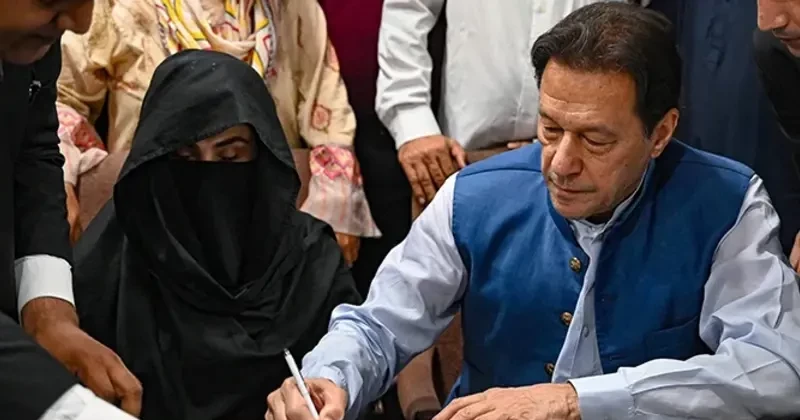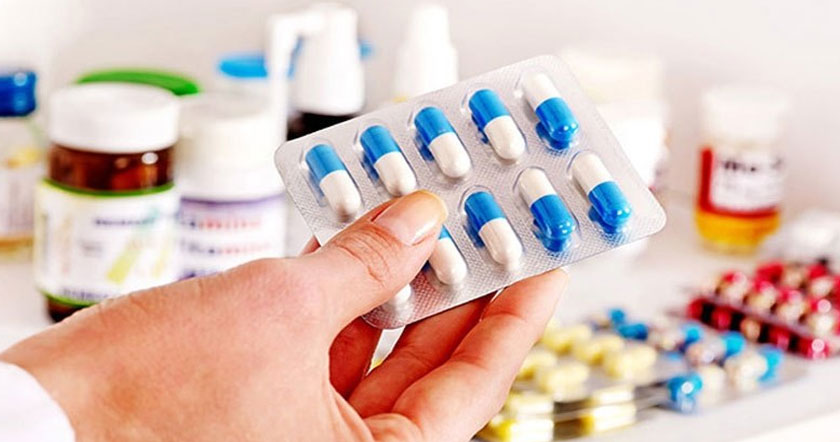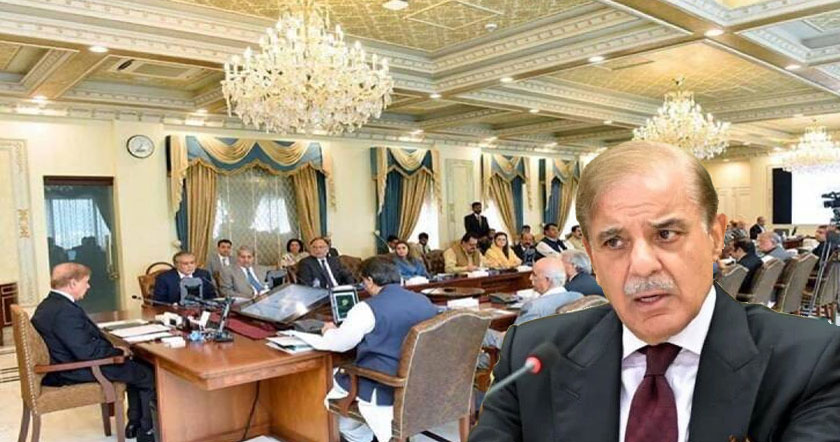The latest national health survey in Pakistan indicates rising immunization rates, growing access to skilled health care and declining child mortality rates. However, the improvements in education and health care indicators in Pakistan are real but slower than in other countries in South Asia region. Pakistan's human development rankingplunged to 150 in 2018, down from 149 in 2017. It is worse than Bangladesh at 136, India at 130 and Nepal at 149. The decade of democracy under Pakistan People's Party and Pakistan Muslim League (Nawaz) has produced the slowest annual human development growth rate in the last 30 years. The fastest growth in Pakistan human development was seen in 2000-2010, a decade dominated by President Musharraf's rule, according to the latest Human Development Report 2018. One of the biggest challenges facing the PTI government led by Prime Minister Imran Khan is to significantly accelerate human development rates in Pakistan.
Pakistan Demographic and Health Survey:
PDHS (Pakistan Demographic and Health Survey) is a nationally-representative household survey that provide data for a wide range of monitoring and impact evaluation indicators in the areas of population, health, and nutrition. It is conducted about every 5 years.
The 2017-18 Pakistan Demographic and Health Survey (2017-18 PDHS) was carried out by the National Institute of Population Studies (NIPS), Islamabad, Pakistan. It involved 16,240 households. ICF provided technical assistance through The DHS Program, a project funded by the United States Agency for International Development (USAID) that provides support and technical assistance in the implementation of population and health surveys in countries worldwide.
Declining infant mortality rate:
The infant mortality rate (IMR), defined as the number of deaths in children under 1 year of age per 1000 live births in the same year, is universally regarded as a highly sensitive (proxy) measure of population health. A declining rate is an indication of improving health. IMR in Pakistan has declined from 86 in 1990-91 to 74 in 2012-13 and 62 in the latest survey in 2017-18.
During the 5 years immediately preceding the survey, the infant mortality rate (IMR) was 62 deaths per 1,000 live births. The child mortality rate was 13 deaths per 1,000 children surviving to age 12 months, while the overall under-5 mortality rate was 74 deaths per 1,000 live births. Eighty-four percent of all deaths among children under age 5 in Pakistan take place before a child’s first birthday, with 57% occurring during the first month of life (42 deaths per 1,000 live births).
Rising Vaccination Rate:
Vaccines are proven to prevent infectious disease and spread of such disease among children and the larger populations. Polio, measles, diphtheria, pertussis (whooping cough), rubella (German measles), mumps, tetanus, rotavirus and Haemophilus influenzae type b (Hib) can now be prevented by vaccination.
The latest PDHS survey indicates that 66% of the children in Pakistan have received all basic vaccinations, up from 35% in 1990-91 and 55% in 2012-13. Only 4% have had no vaccinations, down from 28% in 1990-91.
Pre-Natal and Delivery Care:
Access to proper medical care and hygiene during delivery can reduce the risk of complications and infections that may lead to death or serious illness for the mother, baby, or both (Van Lerberghe and De Brouwere 2001; WHO 2006). PDHS survey data show that in Pakistan, 69% of the births in the 5 years preceding the survey were delivered by a skilled provider, and 66% were delivered in a health facility.
There has been steady improvement of the maternal health care indicator for women receiving ante-natal care (ANC) from a skilled provider, which increased from 26% in 1990-91 to 86% in 2017-18. Similar improvement in the percentage of deliveries at health facilities has been witnessed; these deliveries increased from 13% to 66%. Also, the percentage of births attended by skilled providers increased from 17% to 69% over the same period of time, according to PDHS 2017-18.
Birth Rates Declining:
Pakistan has seen a steady decline in fertility rates over time, from 5.4 births per woman as reported in the 1990-91 PDHS to 3.6 births per woman in the 2017-18 PDHS—a drop of about two births per woman in almost three decades. However, the decline is minimal in the recent period.
There has been a consistent decrease in fertility among all age groups over the last four DHS surveys, though the decline is less pronounced recently.
Human Development Ranking:
It appears that improvements in education and health care indicators in Pakistan are slower than other countries in South Asia region. Pakistan's human development ranking plunged to 150 in 2018, down from 149 in 2017. It is worse than Bangladesh at 136, India at 130 and Nepal at 149. The decade of democracy under Pakistan People's Party and Pakistan Muslim League (Nawaz) has produced the slowest annual human development growth rate in the last 30 years. The fastest growth in Pakistan human development was seen in 2000-2010, a decade dominated by President Musharraf's rule, according to the latest Human Development Report 2018.
UNDP’s Human Development Index (HDI) represents human progress in one indicator that combines information on people’s health, education and income.
Pakistan saw average annual HDI (Human Development Index) growth rate of 1.08% in 1990-2000, 1.57% in 2000-2010 and 0.95% in 2010-2017, according to Human Development Indices and Indicators 2018 Statistical Update. The fastest growth in Pakistan human development was seen in 2000-2010, a decade dominated by President Musharraf's rule, according to the latest Human Development Report 2018.
Child Nutrition:
PDHS survey shows that the nutritional status of children in Pakistan has improved over the last five years. The percentage of stunted children declined from 45% in 2012-13 to 38% in the 2017-18. A similar downward trend, from 30% to 23%, was observed for underweight children over the same period. Children who are wasted also declined from 11% to 7%. Children who are obese remained at 3% over this period.
Summary:
There are rising vaccination rates and growing access to skilled health care with declining child mortality in Pakistan, according to the latest national health survey in Pakistan. Neonatal mortality rate is down from 55 to 42 per 1,000 births in the last 5 years. Vaccination rates are up with 66% of the children in Pakistan having received all basic vaccinations in 2017-18, up from 35% in 1990-91 and 55% in 2012-13. Only 4% have had no vaccinations in 2017-18, down from 28% in 1990-91.
Skilled health care professionals are delivering 69% of children now, up from 48% five years ago. 66% of children are now vaccinated, up from 54% five years earlier. Infant mortality rate (IMR) within first year of birth was recorded at 62 deaths per 1,000 live births, down from 74 in the last survey of 2012-13. Total Fertility Rate (TFR) has declined from 5.4 births per woman 990-91 to 3.6 births per woman in 2017-18. It appears that improvements in education and health care indicators in Pakistan are slower than other countries in South Asia region.
Pakistan's human development ranking plunged to 150 in 2018, down from 149 in 2017. It is worse than Bangladesh at 136, India at 130 and Nepal at 149. The decade of democracy under Pakistan People's Party and Pakistan Muslim League (Nawaz) has produced the slowest annual human development growth rate in the last 30 years.
The fastest growth in Pakistan human development was seen in 2000-2010, a decade dominated by President Musharraf's rule, according to the latest Human Development Report 2018. One of the biggest challenges facing the PTIgovernment led by Prime Minister Imran Khan is to significantly accelerate human development rates in Pakistan.
http://www.riazhaq.com/2019/03/pakistan-survey-reveals-positive-trends.html
Pakistan Demographic and Health Survey:
PDHS (Pakistan Demographic and Health Survey) is a nationally-representative household survey that provide data for a wide range of monitoring and impact evaluation indicators in the areas of population, health, and nutrition. It is conducted about every 5 years.
The 2017-18 Pakistan Demographic and Health Survey (2017-18 PDHS) was carried out by the National Institute of Population Studies (NIPS), Islamabad, Pakistan. It involved 16,240 households. ICF provided technical assistance through The DHS Program, a project funded by the United States Agency for International Development (USAID) that provides support and technical assistance in the implementation of population and health surveys in countries worldwide.
Declining infant mortality rate:
The infant mortality rate (IMR), defined as the number of deaths in children under 1 year of age per 1000 live births in the same year, is universally regarded as a highly sensitive (proxy) measure of population health. A declining rate is an indication of improving health. IMR in Pakistan has declined from 86 in 1990-91 to 74 in 2012-13 and 62 in the latest survey in 2017-18.
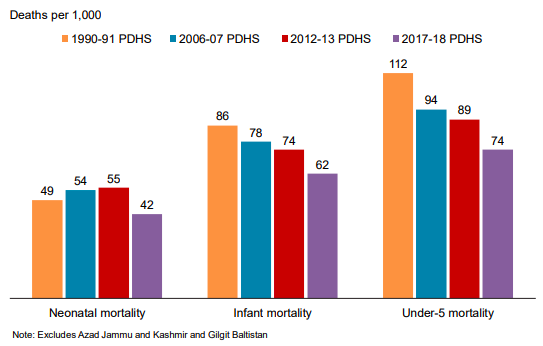
|
| Pakistan Child Mortality Rates. Source: PDHS 2017-18 |
During the 5 years immediately preceding the survey, the infant mortality rate (IMR) was 62 deaths per 1,000 live births. The child mortality rate was 13 deaths per 1,000 children surviving to age 12 months, while the overall under-5 mortality rate was 74 deaths per 1,000 live births. Eighty-four percent of all deaths among children under age 5 in Pakistan take place before a child’s first birthday, with 57% occurring during the first month of life (42 deaths per 1,000 live births).
Rising Vaccination Rate:
Vaccines are proven to prevent infectious disease and spread of such disease among children and the larger populations. Polio, measles, diphtheria, pertussis (whooping cough), rubella (German measles), mumps, tetanus, rotavirus and Haemophilus influenzae type b (Hib) can now be prevented by vaccination.
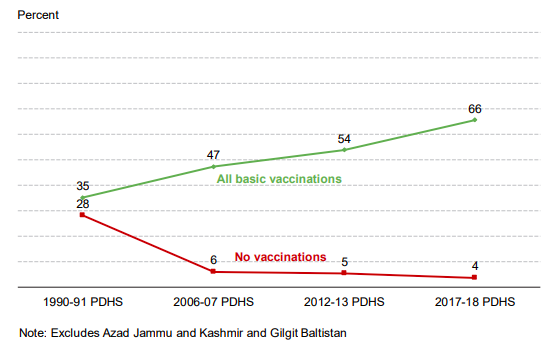
|
| Childhood Vaccination Rate in Pakistan. Source: PDHS |
The latest PDHS survey indicates that 66% of the children in Pakistan have received all basic vaccinations, up from 35% in 1990-91 and 55% in 2012-13. Only 4% have had no vaccinations, down from 28% in 1990-91.
Pre-Natal and Delivery Care:
Access to proper medical care and hygiene during delivery can reduce the risk of complications and infections that may lead to death or serious illness for the mother, baby, or both (Van Lerberghe and De Brouwere 2001; WHO 2006). PDHS survey data show that in Pakistan, 69% of the births in the 5 years preceding the survey were delivered by a skilled provider, and 66% were delivered in a health facility.
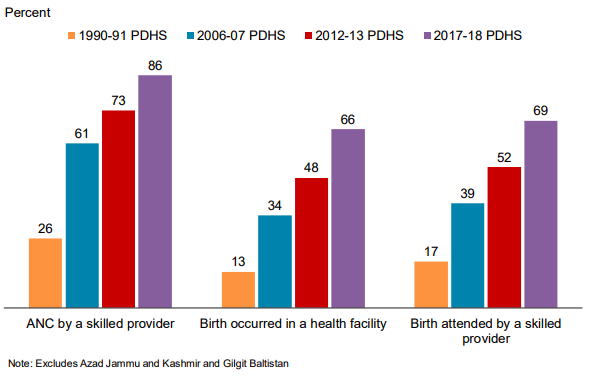
|
| Pre-Natal and Delivery Care in Pakistan. Source: PDHS |
There has been steady improvement of the maternal health care indicator for women receiving ante-natal care (ANC) from a skilled provider, which increased from 26% in 1990-91 to 86% in 2017-18. Similar improvement in the percentage of deliveries at health facilities has been witnessed; these deliveries increased from 13% to 66%. Also, the percentage of births attended by skilled providers increased from 17% to 69% over the same period of time, according to PDHS 2017-18.
Birth Rates Declining:
Pakistan has seen a steady decline in fertility rates over time, from 5.4 births per woman as reported in the 1990-91 PDHS to 3.6 births per woman in the 2017-18 PDHS—a drop of about two births per woman in almost three decades. However, the decline is minimal in the recent period.
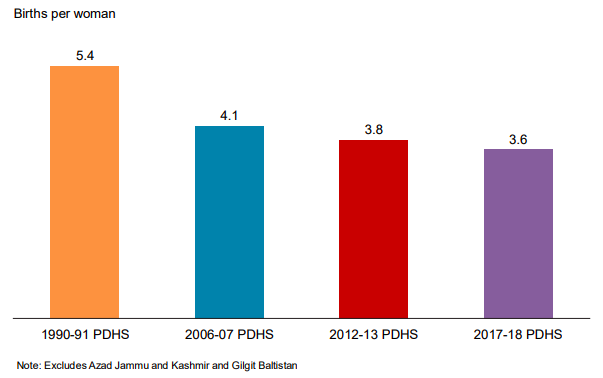
|
| Total Fertility Rate (TFR) in Pakistan. Source: PDHS |
There has been a consistent decrease in fertility among all age groups over the last four DHS surveys, though the decline is less pronounced recently.
Human Development Ranking:
It appears that improvements in education and health care indicators in Pakistan are slower than other countries in South Asia region. Pakistan's human development ranking plunged to 150 in 2018, down from 149 in 2017. It is worse than Bangladesh at 136, India at 130 and Nepal at 149. The decade of democracy under Pakistan People's Party and Pakistan Muslim League (Nawaz) has produced the slowest annual human development growth rate in the last 30 years. The fastest growth in Pakistan human development was seen in 2000-2010, a decade dominated by President Musharraf's rule, according to the latest Human Development Report 2018.
UNDP’s Human Development Index (HDI) represents human progress in one indicator that combines information on people’s health, education and income.
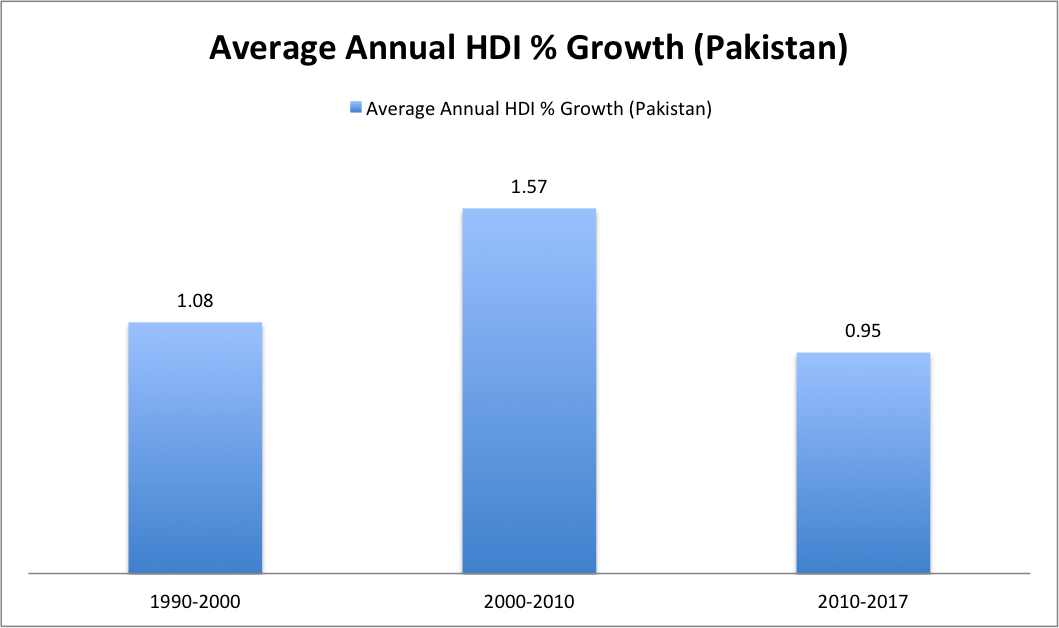
|
| Pakistan's Human Development Growth Rate By Decades. Source: HDR 2018 |
Pakistan saw average annual HDI (Human Development Index) growth rate of 1.08% in 1990-2000, 1.57% in 2000-2010 and 0.95% in 2010-2017, according to Human Development Indices and Indicators 2018 Statistical Update. The fastest growth in Pakistan human development was seen in 2000-2010, a decade dominated by President Musharraf's rule, according to the latest Human Development Report 2018.
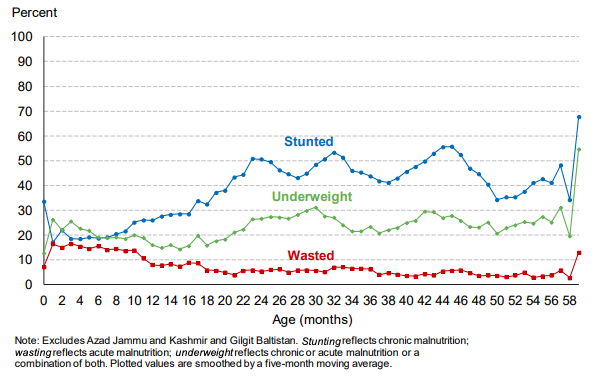
|
| Child Nutrition in Pakistan. Source: PDHS |
Child Nutrition:
PDHS survey shows that the nutritional status of children in Pakistan has improved over the last five years. The percentage of stunted children declined from 45% in 2012-13 to 38% in the 2017-18. A similar downward trend, from 30% to 23%, was observed for underweight children over the same period. Children who are wasted also declined from 11% to 7%. Children who are obese remained at 3% over this period.
Summary:
There are rising vaccination rates and growing access to skilled health care with declining child mortality in Pakistan, according to the latest national health survey in Pakistan. Neonatal mortality rate is down from 55 to 42 per 1,000 births in the last 5 years. Vaccination rates are up with 66% of the children in Pakistan having received all basic vaccinations in 2017-18, up from 35% in 1990-91 and 55% in 2012-13. Only 4% have had no vaccinations in 2017-18, down from 28% in 1990-91.
Skilled health care professionals are delivering 69% of children now, up from 48% five years ago. 66% of children are now vaccinated, up from 54% five years earlier. Infant mortality rate (IMR) within first year of birth was recorded at 62 deaths per 1,000 live births, down from 74 in the last survey of 2012-13. Total Fertility Rate (TFR) has declined from 5.4 births per woman 990-91 to 3.6 births per woman in 2017-18. It appears that improvements in education and health care indicators in Pakistan are slower than other countries in South Asia region.
Pakistan's human development ranking plunged to 150 in 2018, down from 149 in 2017. It is worse than Bangladesh at 136, India at 130 and Nepal at 149. The decade of democracy under Pakistan People's Party and Pakistan Muslim League (Nawaz) has produced the slowest annual human development growth rate in the last 30 years.
The fastest growth in Pakistan human development was seen in 2000-2010, a decade dominated by President Musharraf's rule, according to the latest Human Development Report 2018. One of the biggest challenges facing the PTIgovernment led by Prime Minister Imran Khan is to significantly accelerate human development rates in Pakistan.
http://www.riazhaq.com/2019/03/pakistan-survey-reveals-positive-trends.html





















